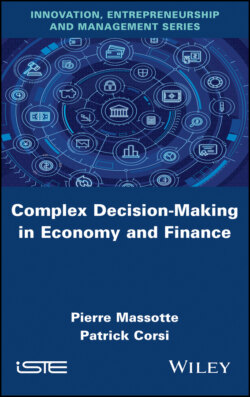Читать книгу Complex Decision-Making in Economy and Finance - Pierre Massotte - Страница 15
I.4. Guidelines and ways forward I.4.1. Strategic risk management
ОглавлениеVarious events of this century (say the attacks of September 2001, the viticulture crisis, the textile crisis, etc.) considerably change the context, and also the perception of what is commonly called “risk”. In the frame of reference of this book, risk translates into physical or human losses, and greater vulnerability to global economic, technological and social change. We live in a complex world full of uncertainties and the two questions that first arise are: what awareness do we have of the potential risks? What is the impact of low noise or ICS on a system for which the consequences will be incalculable?
We are subject to an immense variety of operational risks and local disruptions which impact our entire interacting network. At the approach level, lots of effort and money are being spent to keep systems in their current state, to reduce potential risks and the risk of a downward spiral. But is such an approach relevant? By recalling the concerns of economy, they mainly concern: the increase in companies’ turnover and economic growth, the reduction of costs, the increase in market shares in the most developed countries or in those towards which purchasing power is shifted, and finally, better access to new knowledge. Similarly, competitive pressure is forcing companies to move beyond their local or national framework to export.
These combined phenomena will complicate the processes to refine and optimize them. Concurrently, operations are being internationalized. There, known and unknown risks increase. For instance:
– outsourcing implies an improvement in productivity, a reduction in costs, as well as higher logistics costs (costs of delays, costs of risks related to stock shortages, etc.);
– the creation of subsidiaries abroad leads to higher transition costs as well as to more difficulty in control of strategy and operations;
– no longer being hesitant to relocate a growing part of the value chain. Outsourcing is based on often fragile networks: we are in an unstable and unpredictable mode, higher organizational costs, etc.
Some economists note that the notion of cost or productivity alone is no longer sufficient: certainly, manufacturing and technological costs have been reduced, but changing context and culture leads to an increase in social cost.
Thus, given that studies are generally not conducted in a comprehensive manner, it is difficult to measure the impact of changes and the new complexity of our systems. In which direction should we go? Realizing that you cannot understand everything, you have to change your paradigm and focus on two points:
– Strategic Risk Management. Without going into detail, this method implies that it is necessary to identify high value-added processes, key infrastructures and assess their vulnerability.
– Strategic Opportunity. The world is characterized by rapid change, it is volatile: customers change, so do their aspirations, tastes, preferences, wants and needs. Choice is not allowed because gaps between countries are widening and, if one does not respond to new needs and challenges, one will be overtaken by its competition. It is therefore a question of seizing opportunities and “conditioning” oneself in this sense.
